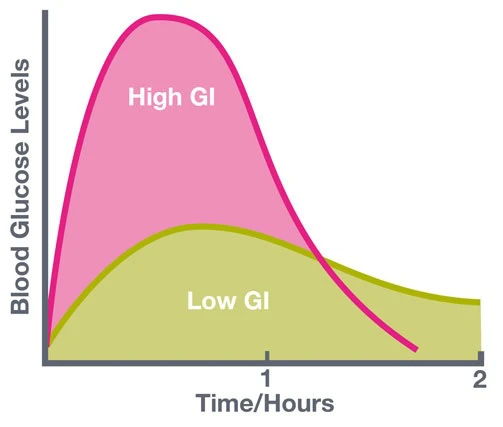The Glycemic Index (GI) is a ranking system that measures the impact of carbohydrates on our blood sugar levels. It assigns a numerical value to food based on how quickly the carbohydrates in that food are digested and absorbed.
In this article, we will discuss the benefits of following a diet based on the Glycemic Index and provide tips for incorporating low GI foods into your daily routine.
Definition of the Glycemic (Glycaemic) Index
The glycemic index or glycaemic index (GI) is an important tool used to measure the effect of different foods on blood sugar (glucose) levels.
The GI ranks carbohydrates on a scale from 0 to 100 according to their effect on blood sugar levels.
Foods with a high GI (70 or higher) are broken down quickly, causing blood sugar and insulin levels to rise quickly. Foods with a low GI (55 or lower) are broken down more slowly, resulting in a gradual rise in blood sugar and insulin levels.
How Does the Glycemic Index Work?
When carbohydrates are consumed, they are broken down into glucose in the small intestine, which is then absorbed into the bloodstream. The resulting rise in blood glucose levels triggers the release of insulin from the pancreas.
Insulin helps to store glucose in cells for energy or convert it into fat for storage. The rate at which this process occurs varies greatly depending on the type of carbohydrate being consumed.
High-GI foods cause a rapid rise and fall in blood sugar and insulin levels, while low-GI foods result in a slower, steadier rise and fall.
How Is Glycemic Index Measured?
The glycemic index is measured by comparing the effects of a given carbohydrate food to that of pure glucose, which has been assigned a GI value of 100.
Foods are tested on a group of 10-15 people who consume 50 grams of available carbohydrates from the food being tested after an overnight fast. Blood samples are taken every 15 minutes over a two hour period to measure changes in blood glucose levels.

Glycemic Index Blood Glucose Level Graph
The area under the curve (AUC) is then calculated by multiplying the average blood sugar response by the length of time over which it occurs. This AUC number is then compared to that of pure glucose, and a GI value is assigned based on this comparison.
Here we explained in more details how glycemic index is calculated.
What Are the Levels of Glycemic Index?
Low: 55 or less
Medium: 56-69
High: 70 and above
Examples of Foods With High GI:
- White bread – 73
- Instant mashed potatoes – 82
- White rice – 87
- Watermelon – 72
- Pretzels – 83
Examples of Foods With Low GI:
- Oatmeal – 55
- Apples – 41
- Kidney beans – 28
- Barley – 25
- Spaghetti (whole wheat) – 42
Benefits of Glycemic Index
Glycemic index can be useful for weight loss and people with diabetes as well as those trying to maintain healthy blood sugar levels.
Low-GI diets have been shown to help people lose weight and improve their overall health by reducing hunger and cravings for sugary snacks between meals.
For people with diabetes, consuming low-GI foods helps reduce spikes in blood sugar that can lead to complications such as heart disease and stroke. On the other , high-GI foods can be beneficial when energy needs are high or when exercise is performed shortly after eating them due to their rapid absorption into the bloodstream.
Potential Limitations Of Glycemic Index:
Although glycemic index can be useful for helping people make healthier food choices, there are some potential limitations that should be taken into consideration when using it as a guide for eating habits.
For example, individual responses to different carbohydrate foods may vary greatly from person to person due to differences in digestion speed and other factors such as how much fat or fiber is consumed with them.
Another fact to consider is that glycemic index number for the same food can vary vastly based on the ripeness, cooking method, and the sort of sugar it contains. Thus, it is not an easy task to know exactly the GI of the food you are about to eat.
Additionally, glycemic load (GL), which takes into account both GI value and how much carbohydrate is actually consumed per serving size, may be more accurate than GI alone in predicting how certain foods affect blood sugar levels over time. Therefore, it’s important to take into account both GI values and GL values when making dietary decisions based on glycemic index alone.


